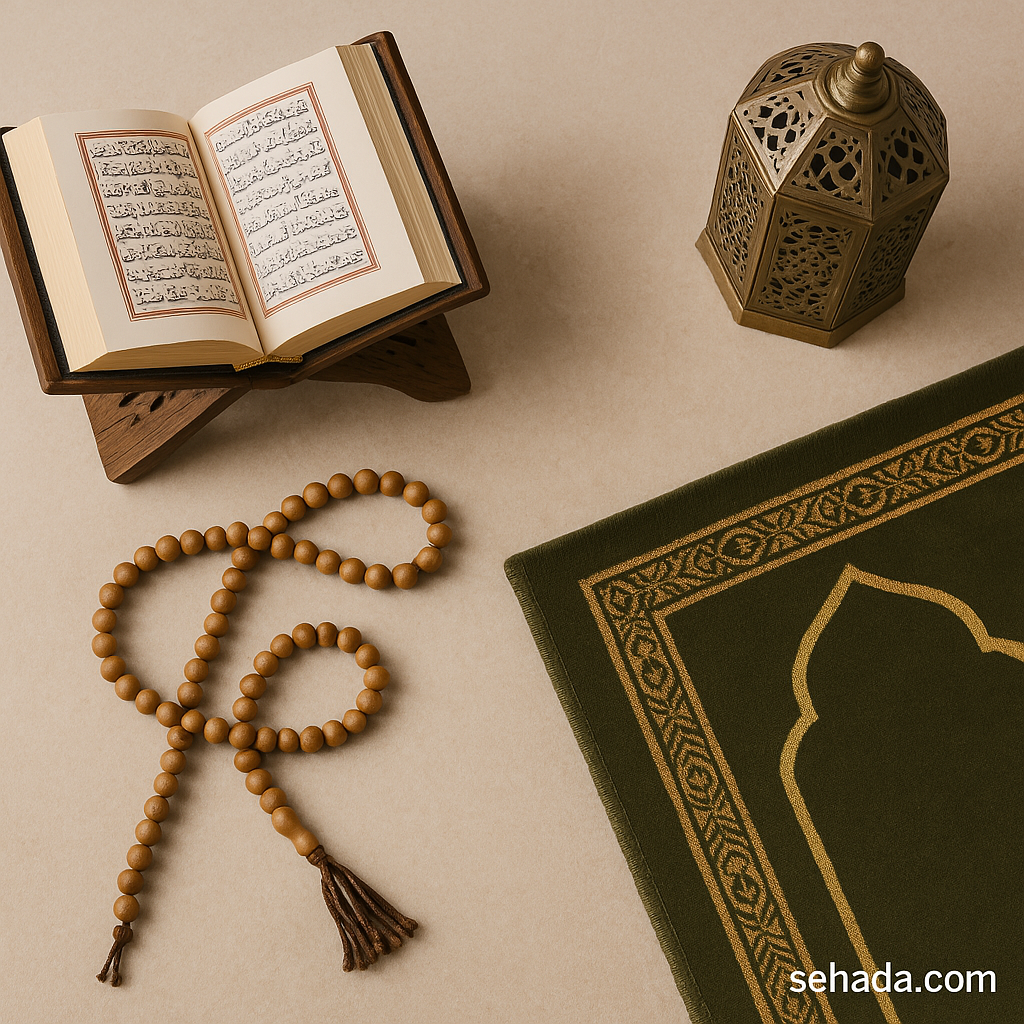Prophetic Practices for Holistic Well-Being
🕌 Prophetic Practices for Holistic Well-Being
Discover how Prophetic Sunnah offers a complete guide to holistic health—spiritually grounded, physically balanced, and emotionally healing.
✨ DEL 1: The Prophetic Model of Holistic Health
The pursuit of well-being in our times often feels like an overwhelming puzzle—fragmented advice from self-help books, trendy diets, short-lived wellness fads, and social media influencers all compete to define what it means to be healthy. In the noise of this global health marketplace, the Prophetic model of holistic wellness offers something profoundly different: not just a lifestyle, but a sacred rhythm, a divinely balanced path for body, mind, and soul. The life of Prophet Muhammad ﷺ was not merely spiritual; it was integrally human. It provided not only a roadmap for moral conduct but also an intricate blueprint for health, healing, and balance that speaks across time and culture. To understand the Prophetic model of holistic health is to reorient the entire discussion of wellness back to its rightful core—the alignment between the human being and his Creator, his body, his emotional world, his environment, and his fellow human beings.
At the heart of this model is the concept of fitrah—the innate, God-given nature of every human being. Fitrah is not just a theological abstraction; it is a lived instinct toward balance, purity, and harmony. The Prophetic Sunnah does not aim to override this fitrah with rules; rather, it nurtures it, refines it, and protects it from the corrosive forces of excess, negligence, or distortion. Every Prophetic practice—from the way one eats, sleeps, speaks, walks, purifies the body, or organizes time—is designed to preserve and optimize the fitrah. The Prophetic approach to health is not mechanical, and certainly not reductionist. It never sees the body as a machine to be manipulated for aesthetics or performance, nor does it treat the soul as a vague spiritual entity divorced from the material world. Instead, the body is viewed as an amanah, a trust from Allah, intricately connected to the heart (qalb) and the intellect (aql), each influencing the other in a seamless feedback loop of health or harm.
When the Prophet ﷺ taught moderation, he was not just warning against overeating or overexertion. He was building a worldview. He taught that extremism—in diet, behavior, emotion, or thought—leads to imbalance, and imbalance leads to breakdown. In this sense, the Sunnah does not merely offer actions to copy; it offers a philosophy of wellness grounded in moderation (wasatiyyah), intentionality (niyyah), and excellence (ihsan). His own life was a mirror of this harmony. He was physically strong but not obsessed with strength, emotionally deep but never overwhelmed, spiritually connected but never disconnected from the needs of his family or society. His health practices were never rigid routines, but deeply meaningful acts anchored in consciousness of God.
One of the most striking features of the Prophetic model is its seamless integration of the sacred and the practical. There is no dichotomy between prayer and health, between spiritual acts and physical ones. Wudu, the ritual washing before prayer, is also a means of maintaining cleanliness and preventing disease. Fasting is not only a command but a purification of the body and soul. Dhikr (remembrance of Allah) does not merely nourish the heart—it calms the nervous system, lowers anxiety, and centers attention. This unity of purpose avoids the fragmentation we see today, where spiritual people neglect their health and fitness enthusiasts often neglect their souls.
Modern psychology and medicine are only beginning to catch up to what the Prophetic tradition has emphasized for over 1,400 years: emotional well-being is not a luxury, but a necessity; social connection is part of healing; belief, purpose, and gratitude are potent forces in recovery and resilience. The Prophet ﷺ validated grief, offered solace in sorrow, and encouraged expression of feelings. He cried. He smiled often. He touched people when he spoke. These are not just moral qualities—they are neurobiological gifts that regulate emotion and strengthen bonds, essential to holistic wellness.
Equally profound is the Prophetic relationship with time. The division of the day through salah (prayer) creates not only spiritual discipline but circadian regulation. The call to prayer becomes a call to realignment—with the body, with focus, with God. The Prophet ﷺ encouraged napping at midday (qailulah), waking before dawn (tahajjud), and sleeping early—all of which align with modern sleep science. His physical habits modeled efficiency and elegance. He walked briskly, ate simply, slept in moderation, and was active. Every act, no matter how ordinary, was an opportunity to come closer to the Creator.
At the core of it all is the concept of barakah—divine blessing. Barakah is not measurable by calories or metrics, but it determines the quality, impact, and sustainability of any action. The Prophet ﷺ taught that blessing lies not in abundance, but in moderation and sincerity. In reconnecting with the Prophetic model of health, we reawaken a worldview—one that heals not only the body but the modern self, not just with discipline, but with mercy.

✨ DEL 2: Prophetic Practices in Action
To understand the full beauty of the Prophetic model of wellness, one must step into the lived reality of the Prophet ﷺ. His habits were tactile, consistent, and deeply human. Eating was done with presence and humility. He ate only when hungry, favored simple foods—dates, honey, barley, milk, olive oil, vinegar—and stopped before fullness. He sat while eating, said the name of Allah, and expressed gratitude after meals. These were not habits of convenience; they were spiritual postures. Modern science confirms the health benefits of nearly every food he consumed and the benefits of mindful eating, but more than that, his intention transformed food into worship.
Fasting was a rhythm of his week and month—not just in Ramadan. Mondays, Thursdays, and the white days of the lunar calendar were observed regularly. Fasting served as spiritual purification and metabolic reset, now validated by modern medicine as protective against inflammation and chronic disease. Yet the Prophet ﷺ fasted not to lose weight, but to strengthen taqwa, compassion, and self-mastery. This is the essence of prophetic wellness: integrating body and soul in each action.
Sleep in the Prophetic tradition was both structured and spiritual. The Prophet ﷺ slept on his right side, recited supplications, avoided heavy food before bed, and woke before dawn. He practiced qailulah (midday nap), now shown to enhance memory and reduce cardiovascular strain. Sleep was a tool for recovery, not escape, and waking was an act of rebirth—beginning with praise to Allah.
His hygiene was exemplary. He performed wudu multiple times daily, washed hands before and after meals, used siwakfor dental hygiene, bathed regularly, trimmed nails, and wore perfume. His appearance was clean and dignified. These were not just habits—they were expressions of inner order and prophetic discipline. Cleanliness was half of faith, and modern health confirms its importance for disease prevention and emotional wellbeing.
Physical activity was seamlessly embedded in his life. He walked fast, encouraged swimming, riding, archery, and even wrestling. He wrestled playfully with children and companions. His strength was real but never for ego. Health, in his model, was for worship, not display.
Emotional wellness was practiced with deep consciousness. He wept at loss, smiled often, forgave quickly, showed empathy, listened fully. Emotional intelligence was not a self-help term—it was Prophetic conduct. He taught that the strongest person is the one who controls anger, and that emotional regulation begins with dhikr and sincere connection to Allah.
Social practices were healing. He greeted all, visited the sick, shared food, forgave enemies, uplifted the weak. Health was not solitary—it was communal. Joy, sadness, healing, and worship were shared experiences. The Prophet ﷺ created a space of radical inclusion where every heart was seen and valued.
Healing itself was holistic. He used black seed (“cure for everything but death”), honey, olive oil, zamzam, cupping, and ruqyah. He affirmed medical treatment while keeping Allah as the ultimate source of shifa. Today, each of these treatments is studied for immune, cardiovascular, and anti-inflammatory benefits. But the healing began with trust in God.
The Sunnah was not a checklist. It was a rhythm. The Prophet ﷺ lived in harmony with the Earth, with people, and with his Lord. Following his way is not about ancient customs—it’s about becoming more human, more present, more whole.

✨ DEL 3: Reviving the Prophetic Blueprint Today
In today’s fractured world—driven by noise, speed, and self-obsession—the Prophetic model is not outdated; it is more urgent than ever. It is not a relic of history, but a manual for sanity. Reviving it requires presence, not perfection. One glass of water with bismillah, one prayer on time, one act of restraint, one moment of gratitude—that is the gateway. The Prophet ﷺ taught us to begin with what is consistent, even if small. His way invites healing through presence, rhythm, and divine alignment.
This revival is not only personal—it is cultural. We are raising children in a world of false metrics. The Sunnah redefines success through sincerity, strength through mercy, health through barakah. It is resistance to commodified wellness and return to sacred living.
We do not need to reinvent the wheel. The Prophetic way is a complete system. We must only return to it—not with guilt, but with love. When we align with the rhythm of revelation, we do not only heal our bodies—we begin to heal our time, our families, and our ummah.

